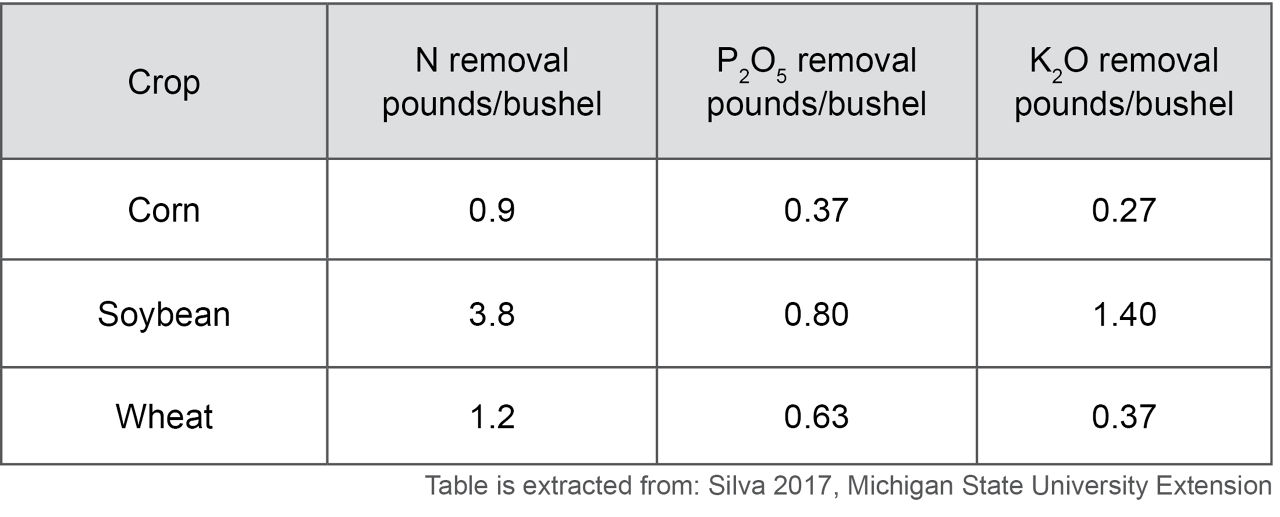5 MIN READ
Fall Fertilizer Application for Upcoming Soybean Crop
September 22, 2019
Farmers in a corn-soybean rotation have generally relied on residual fertility to fulfill the nutrient needs for the succeeding soybean crop. However, because of increasing corn yields and advancing soybean yields, fall fertilization may need to be considered for an upcoming soybean crop. Each bushel of corn can remove about 0.37 pounds of phosphorus (P2O5) and 0.27 pounds of potassium (K2O). With very good to excellent corn yields, substantial amounts of these nutrients can be removed, which may leave the following soybean crop shorthanded. If expectations exist for soybean yields to be excellent (greater than 85 bu/acre as an example), soil testing may be needed to help determine if residual fertility is adequate to support soybean yield expectations. For more information on soil sampling, please read Reading and Interpreting a Soil Test.

Soil Sampling
Soil sampling should be done about every three years in the spring or after harvest in the fall. However, it can be a challenge to get soil samples in the fall and have the results available in time for a fall fertilizer application. As an alternative, fall fertilizer recommendations can be made from previously collected soil samples if nutrient removal from the recently harvested crop is considered.
Soil pH
Soil pH should be around 6.5 for optimal growth. Soil pH decreases through nutrient removal by crops, leaching, and residual acidity from N fertilizers. Low pH may result in the reduced availability of calcium, manganese, and molybdenum. Low soil pH also increases the risk of herbicide carryover from imidazolinone herbicides. Nitrogen fixation is also negatively impacted by low pH. High pH is difficult to lower but awareness allows for better risk management. High soil pH can reduce the availability of iron, manganese, boron, copper, and zinc. High pH also increases the carryover potential of sulfonylurea herbicides.
Lime Application
Lime neutralizes soil acidity and adds calcium (Ca), a nutrient essential to plant growth. Soil pH indicates the level of acidity or alkalinity, while buffer pH is used to determine if needed, the rate of lime application. Lime takes time to dissolve in the soil and neutralize acidity, so apply lime about 3 to 6 months before planting. Applying in the fall provides plenty of time for the lime to dissolve in the soil profile before the next growing season. Lime should be applied and incorporated a month or more before adding fertilizers since it can interfere with the availability of other nutrients, especially phosphorus (P). Pay attention to the different sources of liming material. Differences among products in their neutralizing efficiency (calcium carbonate equivalent and particle size) will influence optimum application rates.
Phosphorus (P) and Potassium (K) Application
Fall is typically the best time for making P and K applications because of workload, dry soils, and availability of fertilizers. Fall is also a good time to apply P for environmental reasons since there is generally a lower risk of P runoff with the typical fall weather and soil conditions. P and K fertilizer should not be applied on frozen ground because applications made to fields with any slope can result in significant runoff and fertilizer loss. Soil test recommendations should be followed to maintain P and K above their respective critical levels for the soil to supply adequate quantities of the nutrients to support optimum plant growth. When maintaining P and K levels, replace what is used by the crop each year (Table 1). With the wide range of crop yields every year, this is important to consider when determining the amount of maintenance fertilizer to apply.
Operating at low soil test levels of these nutrients may reduce yield potential. If soil tests show these nutrients to be above the critical levels, applications are not necessary for the next crop. It is common to apply P and K fertilizer once every two years of crop production. In corn-soybean crop rotation, all of the K can be applied after soybean harvest in the fall ahead of corn. Enough K will be returned to the soil from the corn residue for the soybean crop in the rotation. However, recommended rates of fertilizer should be applied annually to soils that are below critical levels of these nutrients. These annual applications include P and K soil build-up and crop removal needs.
Sources:
Silva, G. 2017. Nutrient removal by grain crops. Michigan State University. https://www.canr.msu.edu
Brouder, S.M., Bongen, A.S., Eck, K.J., and Hawkins, S.E. 2003. Manganese deficiencies in Indiana soils. Agronomy Guide AY-276-W. Purdue University. https://www.agry.purdue.edu/ext/pubs/AY-276-W.pdf
Hoeft, R.G. and Peck, T.R. 2002. Soil testing and fertility. In Illinois Agronomy Handbook, 23rd Edition. College of Agricultural, Consumer, and Environmental Sciences, Dept. Of Crop Sciences, UI Extension, University of Illinois.
Kaiser, D.E. and Bloom, P.R. 2018. Managing Iron Deficiency Chlorosis in soybean. https://extension.umn.edu/crop-specific-needs/managing-iron-deficiency-chlorosis-soybean
Oldham, L., Jones, K., and Crouse, K. 2018. Soybeans: Liming & Fertilization. Information Sheet 873 (POD-07-18). Mississippi State University. http://extension.msstate.edu/publications/soybeans-liming-and-fertilization
(Verified 9/12/19)
8002_S1